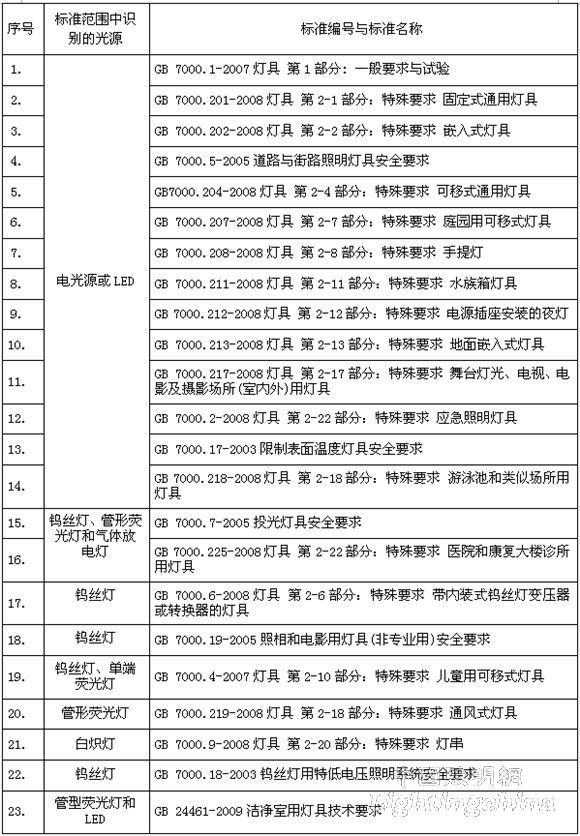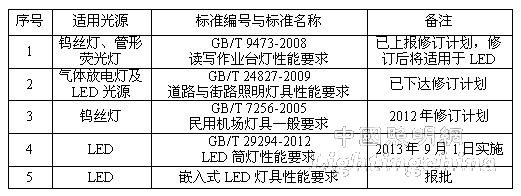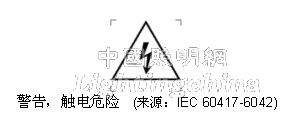The LED luminaire standard is an integral part of the LED lighting standard system. At the same time, due to the maturity of the development and application of LED luminaires, based on the existing product standards, the international and domestic research results on the safety and performance characteristics of LED luminaires will be Reflected in relevant safety standards and performance standards. First, the status quo of China's lighting standards Safety standard The luminaire safety standard consists of the equivalent IEC standard and China's self-developed standards. The national standard for luminaire safety and its applicable light source are shown in Table 1. Table 1 National Standards for Lamp Safety and Applicable Light Sources 2. Performance standards At present, there are 4 national standards for lamp performance (see Table 2), which are all independently formulated by China. Except GB/T 9473-2008 and GB/T 7256-2005, other standards are applicable to LED light source lamps. Table 2 Performance standards for lamps that have been published or approved 3. Method standard The national standards for the three luminaire measurement methods that have been released (see Table 3) are applicable to LED luminaires. The national standard "LED Lamp Reliability Test Method" is in the process of being drafted. Table 3 Standards for luminaire test methods that have been published Second, the development of China's national standards (1) GB 7000.1-2007 "Lamps Part 1: General Requirements and Tests" is being revised GB 7000.1-2007 is being revised. The technical differences include the revised contents of IEC 60598-1:2008 and the revisions of IEC 60598-1:2013. The contents of LED lamps are as follows: 1. Requirements for blue light hazards Luminaires that use a source of safety standards that do not exempt the source of retinal blue light hazard assessment should be evaluated in accordance with IEC/TR 62778, "Application of the IEC 62471 Standard for Evaluating Light Source and Luminous Danger of Luminaires". LED sources with a Blu-ray hazard category greater than RG2 should not be used. More cumbersome management requirements are required for this type of light source. Use of luminaires with RG0 unrestricted or RG1 unrestricted light source rated according to IEC/TR 62778, or for use in a complete assembly evaluated as RG0 unrestricted or RG1 unrestricted, under the same conditions, no requirement for retinal blue light hazard . For lamps with threshold illumination Ethr evaluated in accordance with IEC/TR 62778, the following requirements shall apply: - for fixed luminaires To perform an additional evaluation according to IEC/TR 62778, if it is greater than RG1, find the distance Xm to reach Ethr. When the distance is greater than 200mm, mark on the luminaire that “the luminaire should be placed in the expected distance not to be less than Xm. Point to the position of the luminaire staring at it." - portable and portable lighting For portable and hand-held luminaires that exceed RG1 at 200 mm, the luminaire should be marked with the indication that the luminaire should be placed in a position that is not expected to be staring at the luminaire at a distance less than Xm. - Nightlights for children with removable lamps and power outlets GB 7000.4 "Lamps Part 2-10: Special requirements for children with portable lamps" covered by portable luminaires, and GB 7000.212 "Lamps Part 2-12: Special requirements for power outlets installed night lights" The power socket night light shall not exceed RG1 at 200mm according to IEC/TR 62778. 2. Marking and structural requirements for non-replaceable light sources and non-user replacement light source luminaires (1) Marking requirements - Non-replaceable light source “The light source of this luminaire is irreplaceable; when the light source reaches its end, the entire luminaire should be replaced†- non-user replacement light source “The light source in this luminaire should be replaced by the manufacturer or its service agent or a similar qualified person.†(2) Structural requirements It should not be possible to replace and/or touch live parts without damaging the luminaire and its components. The parts of the luminaire that can be opened by hand or with a tool in order to reach the light source during inspection should be opened or removed. Sealed, glued, or screwed luminaire parts designed or shaped to be used only once, or permanently embedded insulation does not open. After all the above components have been removed, the live parts should not be touched when tested with the test probes and test methods in Chapter 8 of this standard. 3. Requirements for designing the connection of luminaires using standard lamp holders or connectors Use a light source designed to be connected with an IEC 60061 (series) lamp holder or connector, but without the associated lamp holder or connector, use other means (eg soldering directly to the pins with wires) to complete the electrical connection is not allowed . 4. Refine the insulation requirements of LED lamps LED chips have ultra-low voltage, low current electrical characteristics, so LED lamps have different electrical systems than traditional lamps, that is, control circuits with output ultra-low voltage, exposed high thermal conductivity of printed circuit boards close to LED packages Parts, and so on. In order to ensure the safe insulation of the accessible conductive parts of LED lamps under LV power supply, the insulation requirements are specified in the structure of Chapter 4 of IEC 60598-1:2013, as shown in Table 4. Table 4 Insulation requirements between live parts and accessible conductive parts (same table X.1 of IEC 60598-1:2013 FDIS draft) 




April 27, 2024